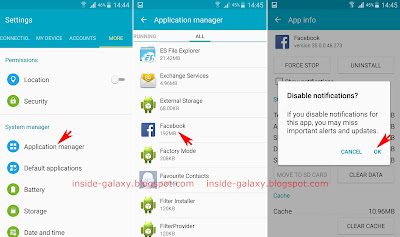By default, lock screen is designed to secure your phone from unauthorized access or other unwanted activities(e.g: pocket dialing, opening an app, etc). But, if needed, you can personalize your lock screen by changing its background image(also called wallpaper). You can set the default wallpapers, any picture stored in your phone, or recommended destinations from Travel wallpaper as your lock screen wallpaper.
How to change lock screen wallpaper?
In this post, we'll try to change lock screen wallpaper by using two different methods: from the home screen and from the settings menu.
Method #1: From the home screen
If your Samsung Galaxy S4 has been updated to
Android 5.0.1 Lollipop, you can use the following steps to change your lock screen wallpaper:
- While you're on home screen, tap the Menu key or long tap on a blank area in the home screen.
- Tap Wallpapers button
 at the bottom of the screen.
at the bottom of the screen.
- Select Lock screen from the provided options displayed at the top of the screen.
- To use default static wallpaper go to the step #5, to use travel wallpaper go to the step #6, while to use your own picture as lock screen wallpaper go to the step #7.
- Use a default static wallpaper as lock screen wallpaper:
- Swipe the provided static wallpapers at the bottom of the screen to the left or to the right and then tap the required static wallpaper.
- Tap Set as wallpaper button at the bottom of the screen.
- The selected static wallpaper will be applied to your lock screen.
- Use Travel wallpaper as lock screen wallpaper:
- Swipe the provided wallpapers at the bottom of the screen to the rightmost and then tap Travel wallpaper.
- If needed, you can change the rate at which the travel wallpaper changes by tapping Interval and then select Every 6 hours, Every 12 hours or Every 24 hours.
- Tap Set wallpaper button.
- Travel wallpaper will be set as your lock screen wallpaper.
- Set your own picture as lock screen wallpaper:
- Tap From Gallery thumbnail at the bottom of the screen.
- Select the required picture from the Gallery app.
- If needed, you can adjust the area of the selected picture that will be used as wallpaper.
- Tap Save button.
- The selected picture will be set as lock screen wallpaper.

Method #2: From the settings menu
You can change your lock screen wallpaper from the settings menu by using the following steps:
- On any screen, swipe down the top of the screen to open up the notifications panel and then tap
 at the top right to go to the settings menu.
at the top right to go to the settings menu.
- Tap My device tab.
- Tap Display.
- Tap Wallpaper.
- Select Lock screen from the provided options displayed at the top of the screen.
- To use default static wallpaper go to the step #7, to use Travel wallpaper go to the step #8, while to use your own picture as lock screen wallpaper go to the step #9.
- Use a default static wallpaper as lock screen wallpaper:
- Swipe the provided static wallpapers at the bottom of the screen to the left or to the right and then tap the required static wallpaper.
- Tap Set as wallpaper button at the bottom of the screen.
- The selected static wallpaper will be applied to your lock screen.
- Use Travel wallpaper as lock screen wallpaper:
- Swipe the provided wallpapers at the bottom of the screen to the rightmost and then tap Travel wallpaper.
- If needed, you can change the rate at which the travel wallpaper changes by tapping Interval and then select Every 6 hours, Every 12 hours or Every 24 hours.
- Tap Set wallpaper button.
- Travel wallpaper will be set as your lock screen wallpaper.
- Set your own picture as lock screen wallpaper:
- Tap From Gallery thumbnail at the bottom of the screen.
- Select the required picture from the Gallery app.
- If needed, you can adjust the area of the selected picture that will be used as wallpaper.
- Tap Save button.
- The selected picture will be set as lock screen wallpaper.
 at the top right to go to the settings menu.
at the top right to go to the settings menu.
























